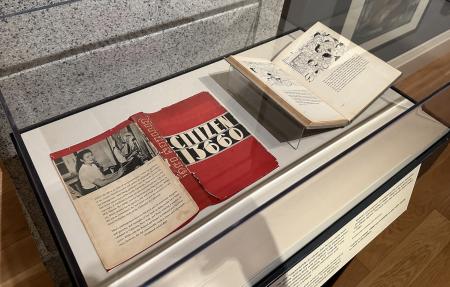This March, art history major Myra McCants presented a paper at the Richard Macksey National Undergraduate Humanities Research Symposium at Johns Hopkins University on imagery of the Japanese incarceration in Ansel Adams’ photo essay Born Free and Equal (1944) and Miné Okubo’s illustrated memoir Citizen 13660 (1946). The Macksey Symposium is a cross-disciplinary undergraduate symposium that brings together students across all fields of the humanities to present their work to a national audience.
McCants’ research comes out of an interest in the relationship between these two depictions of the experience of Japanese incarcerees: one by an outsider, a renowned landscape photographer, and one by an insider, an American artist and writer of Japanese descent who was forced to relocate to a Japanese American concentration camp. Noticing a lack of scholarly research comparing these two notable books, McCants’ initial interest turned into an independent study with art history professor Bert Winther-Tamaki. During her independent study, she worked with the Miné Okubo archives at the Japanese American National Museum and produced the paper which she presented at the Macksey Symposium. Prof. Winther-Tamaki had high praise for McCants’ original archival research, nothing that her “keen critical approach to a highly significant historical subject is contributing truly meaningful insights to current debate.”

For McCants, Okubo’s and Adams’ books represent two very different means of documenting the incarcerated Japanese Americans, but she sees parallels in both artists’ work. Both artists, through their distinct use of images and narratives, challenge the boundaries of truth and subvert the official narratives about incarceration camps as pioneering communities. As a formerly incarcerated person, Okubo’s personal narrative and drawings depict the emotional and psychological impact of being forcibly relocated. Adams, as an outsider, photographed the incarceration camps and their residents in ways that subtly expose the carceral nature of incarceration and also underscore the humanity of the Japanese American incarcerees. Both use their art to humanize a dehumanizing situation.
“Traveling to Johns Hopkins and presenting at the Macksey Symposium,” says McCants, “not only allowed me to improve my public speaking skills and presentation abilities but also provided a chance to connect with fellow peers interested in further advancing and promoting the humanities.” She attended as many sessions as she could to hear what fellow students in the Humanities are working on in universities across the country. She also found time to visit art museums in Baltimore and Washington, D.C.
Five other students in the UCI School of Humanities also participated in the Symposium this year. The School of Humanities has been sponsoring students to present their research Macksey Symposium since 2020, in partnership with other university offices, including the department of Art History. History professor Yong Chen, Associate Dean for Curriculum and Student Services at the School of Humanities, found it a great pleasure to work with Myra McCants this year. “I am grateful for the initiatives she took,” he says, “and I am proud of her amazing work, which exemplifies the wonderful research that Humanities students do at UCI.”
McCants also gave her paper at the SUNY New Paltz Undergraduate Art History Symposium in April. In addition, McCants and the other UCI participants in the Mackesy Symposium will present their research in the poster showcase at the UCI Undergraduate Research Opportunities Program (UROP) Symposium this May.
McCants is a graduating senior who plans to enter the department’s 4+1 program to continue her art history training on the graduate level next year.
